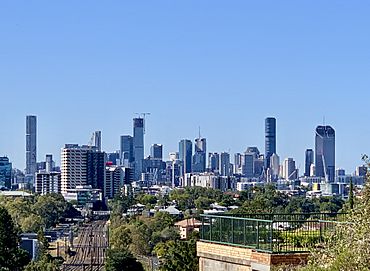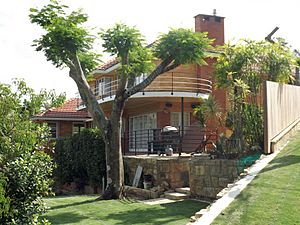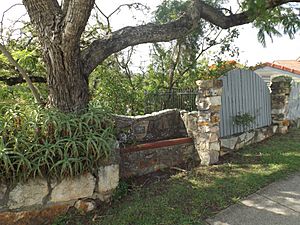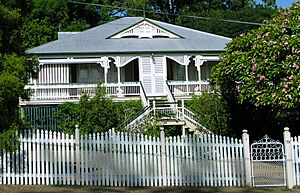Taringa, Queensland facts for kids
Quick facts for kids TaringaBrisbane, Queensland |
|||||||||||||||
|---|---|---|---|---|---|---|---|---|---|---|---|---|---|---|---|

Brisbane skyline seen from Taringa, Queensland.
|
|||||||||||||||
| Postcode(s) | 4068 | ||||||||||||||
| Area | 2.1 km2 (0.8 sq mi) | ||||||||||||||
| Time zone | AEST (UTC+10:00) | ||||||||||||||
| Location | 6.8 km (4 mi) SW of Brisbane CBD | ||||||||||||||
| LGA(s) | City of Brisbane (Walter Taylor Ward) | ||||||||||||||
| State electorate(s) | Maiwar | ||||||||||||||
| Federal Division(s) | Ryan | ||||||||||||||
|
|||||||||||||||
Taringa is a suburb located in the city of Brisbane, Queensland, Australia. In 2021, Taringa had a population of 8,732 people.
Contents
About Taringa's Location
Taringa is about 6.8 kilometers (4.2 miles) southwest of the center of Brisbane. It shares borders with other Brisbane areas like Mt Coot-Tha, Toowong, Indooroopilly, and St Lucia.
The suburb has a ridge running through it, called Swann Road. There are steep slopes on both sides of this ridge. Taringa is mostly a place where people live. There are only a few shops and businesses, mostly along Moggill Road. Many students from the University of Queensland and the Queensland University of Technology like living here. This is because it's close to their universities and to the main city area of Brisbane.
Taringa's History
How Taringa Got Its Name
The name Taringa comes from two Aboriginal words. These words are tarau (meaning "stones") and nga (meaning "made up of"). So, together, the name means "place of stones."
Early Development and Transport
The main railway line from Roma Street station to Indooroopilly station opened on June 14, 1875. The area was first served by West Milton railway station. Later that same year, it was renamed Taringa.
In the late 1800s, land in Taringa was sold off for people to build homes. This included areas like the Abbotsford Estate and the South Toowong Estate. Many small blocks of land were sold.
Community Buildings and Services
A Baptist church opened in Taringa in 1891.
Taringa State School opened its doors on October 8, 1900. It taught students for many years before closing on December 14, 1996.
St Paul's Anglican Church also had its foundation stone laid in 1908. It was located on Moggill Road but was later removed around the 1980s.
A special home for children with disabilities, called the Montrose Home for Crippled, opened in Taringa in 1933. It was in a house donated by a kind person named George Marchant. This home even had its own school, which opened in 1934. The home and school later moved to Corinda.
Who Lives in Taringa?
In 2021, Taringa had 8,732 residents. The average age of people in Taringa is 29 years old. This is younger than the average age for all of Australia.
Most people (63.8%) living in Taringa were born in Australia. Other common countries of birth include England, China, New Zealand, Malaysia, and India. English is the main language spoken at home. Other languages include Mandarin, Cantonese, and Malay.
Historic Places in Taringa


Taringa has several places that are listed as heritage sites. This means they are important historical buildings or places. Some examples include:
- Edge Hills (an old house from the Federation era)
- Au-Argentum (a house built in the California Bungalow style)
- The Taringa Masonic Hall
- The Fulton Residence
- The Pilot Officer Geoffrey Lloyd Wells Memorial Seat
Education in Taringa
Taringa does not have any government schools within its borders. Students usually go to primary schools in nearby suburbs like Toowong, St Lucia, or Indooroopilly. For high school, the closest government school is Indooroopilly State High School.
The Japanese Language Supplementary School of Queensland has its office in Taringa. This school helps Japanese children learn their language on weekends. Their classes are held at Indooroopilly State High School.
Community and Sports
The Taringa Scout Den is a place where the Taringa-Milton-Toowong Scout Group meets. It's also used for GoJu Karate training and Yoga classes.
Taringa is also home to the Taringa Rovers Soccer Football Club. This soccer team plays in the Brisbane Premier League.
Getting Around Taringa
By Train
Taringa railway station is part of the Queensland Rail City network. You can catch trains here to the center of Brisbane, Ipswich, Rosewood, and Springfield.
By Bus
Buses from Transport for Brisbane serve Taringa. You can take a bus to the Brisbane CBD, the University of Queensland, Indooroopilly, and other nearby areas like Chapel Hill and Kenmore.
By Road
The main roads in Taringa are Swann Road and Moggill Road.
Famous People From Taringa
- Gwen Harwood, a well-known Australian poet, was born in Taringa.
- Dorothy Hill, a geologist and palaeontologist, was born here in 1907. She was the first female professor at an Australian university.
- Frank William Moorhouse, who became a chief inspector for fisheries and game in South Australia, was born in Taringa.
- Clement Lindley Wragge, a meteorologist (someone who studies weather), lived in Taringa in the 1890s.
See also
 In Spanish: Taringa (Queensland) para niños
In Spanish: Taringa (Queensland) para niños



